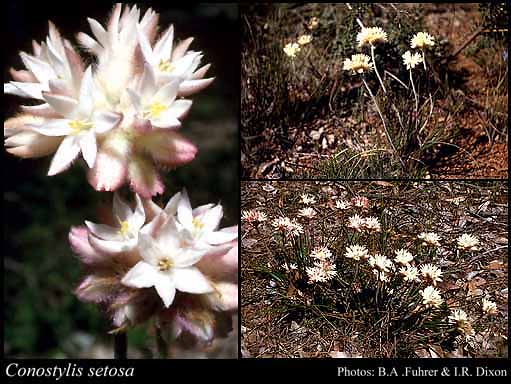- Reference
- Sketch Veg.Swan R. 44 (1840)
- Conservation Code
- Not threatened
- Naturalised Status
- Native to Western Australia
- Name Status
- Current
Rhizomatous, tufted perennial, grass-like or herb, 0.15-0.3 m high. Fl. white/pink-red-brown/purple, Sep to Nov. Laterite, gravel.

Scientific Description
Leaves flat, 85-370 mm long, 1-4 mm wide; bristles or hairs on the leaf margin present, 0.5-5 mm long, with at least some small side branches at the base, straight and rigid or flexuose and soft, angled towards the leaf apex or curved inward over the leaf blade; hairs on the surface of the leaf absent (leaf surfaces glabrous). Scape present, hairy, 120-330 mm long. Inflorescence subtended by a bract 25-30 mm long, with several flowers; floral bracts 10-17 mm long; pedicels present, 2-4 mm long; flowers 10-22 mm long. Perianth hairy, radially symmetrical, suffused with a darker colour over the base colour, white to cream, with six more or less equal tepals, the inner segments 8-12 mm long. Stamens six, in one level; filaments 2.5-6.5 mm long; anther 3-3.4 mm long, without an appendage. Style 14-15 mm long. Flowers in September, October or November. Occurs in the Swan Coastal Plain and Jarrah Forest IBRA bioregion(s), of the South-west Botanical Province.
Distribution
- IBRA Regions
- Jarrah Forest, Swan Coastal Plain.
- IBRA Subregions
- Dandaragan Plateau, Northern Jarrah Forest, Perth, Southern Jarrah Forest.
- Local Government Areas (LGAs)
- Armadale, Beverley, Boddington, Chittering, Cockburn, Gosnells, Harvey, Kalamunda, Kwinana, Mundaring, Murray, Nannup, Perth, Serpentine-Jarrahdale, Swan, Toodyay, Wandering, Waroona.